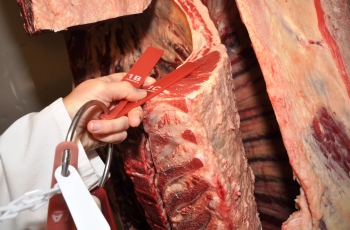Meat Standards Australia (MSA) to remove meat colour as a minimum eligibility requirement
 Meat colour will be removed as a Meat Standards Australia (MSA) eligibility requirement after research has confirmed there is no evidence that meat colour has an impact on eating quality.
Meat colour will be removed as a Meat Standards Australia (MSA) eligibility requirement after research has confirmed there is no evidence that meat colour has an impact on eating quality.
While meat colour has not been part of the MSA grading model, it has been a minimum eligibility requirement under the MSA program, with meat required to fall within AUS-MEAT colours 1B to 3.
However, the importance of pH in eating quality was reaffirmed and the current pH requirements of MSA will remain in place, with MSA eligible carcases needing to be less than pH of 5.71.
As well as confirming that meat colour has no impact on eating quality, the extensive research project also investigated consumer attitudes to meat colour. It revealed that consumers did not discriminate between meat colours 2, 3, 4 and 5 at retail, regardless of packaging type, and where pH was an acceptable level.
MLA General Manager – Producer Consultation and Adoption Michael Crowley said that meat colour had been part of the MSA eligibility requirements in line with industry standards that reflected the then understanding of consumer acceptance of colour, but the new scientific evidence justified its removal.
“This is about using the latest scientific evidence to drive change and continual improvement in the MSA Eating Quality Program,” Mr Crowley said.
“The trial clearly showed that there is no relationship between meat colour at grading, and consumer eating quality.
“The science has proven that regardless of packaging type, consumer acceptance at retail is not impacted – provided pH is below 5.71.”
Mr Crowley said the removal will mostly impact those carcases that pass pH specifications, but currently fail the meat colour requirements – currently representing approximately 1% of all MSA graded cattle.
“This is a positive move forward for MSA as it will allow processors and brandowners to tailor their product specifications to meet their branding needs – without jeopardising integrity and continuing to meet consumer expectations,” Mr Crowley said.
“While meat colour will be removed as an MSA requirement, supply chains may continue to apply a meat colour requirement, captured as a company specification.”
Other industry standards such as the AUSMEAT grainfed specifications will still apply.
The extensive research project involved collecting 24,000 consumer observations and over 10,000 taste test results.
The removal of meat colour has been endorsed by industry through the MSA Beef Taskforce and the Australian Meat Industry Language and Standards Committee. From 1 December, 2016 processors will be able to implement this change into their MSA grading for full industry implementation to be completed by 30 June, 2017.
To find out more about the MSA Eating Quality Program, visit http://www.mla.com.au/marketing-beef-and-lamb/meat-standards-australia/.



